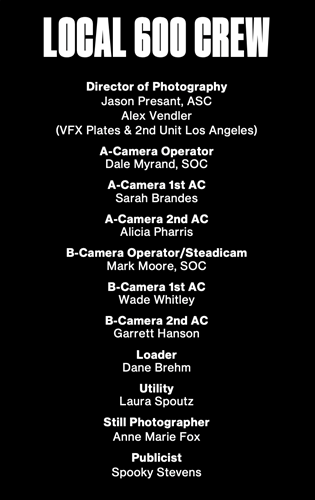by Margot Carmichael Lester, ICG
L.A. Stills by Anne Marie Fox // Frame Grabs & NZ Stills Courtesy of Apple TV+
The word community gets bandied about a lot when talking about production crews. Groups of people with different skills and talents unite behind a shared mission to produce a body of work. It’s how business gets done. But sometimes you come across a crew that shares a set of fundamental beliefs, concepts and attitudes that takes the idea of community to a different level.
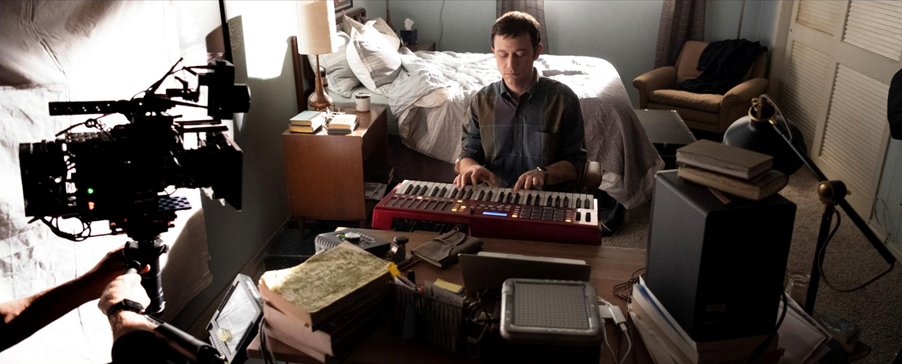
Spend a few minutes talking to the Guild crew on Mr. Corman, a new series from Apple TV+ and writer/director/producer/star Joseph Gordon-Levitt, and that bond is immediately apparent. Director of Photography Jaron Presant, ASC, describes Gordon-Levitt as a “fantastically creative person who elicits the most from those around him.” Presant, a longtime friend and collaborator, adds that “Joe creates a world where those around him become creatively invested, and when that happens it allows everyone to grow and learn. The result is truly empowering.”
Director of Photography Alex Vendler, who shot VFX plates and 2nd Unit in L.A., sums it up this way: “Collective strength is all we have. We don’t want to let people down with whom we’ve had long-term relationships. Trust builds because we believe in each other. I don’t always know what Jaron’s up to, but if he says he needs this, we’ll do it and see why later. He and Joe are at the top of their games, which gives you more excitement. You bring all you’ve got because you feel it’s going to be important.”
That shared commitment was put to the test when Mr. Corman shut down three weeks in due to COVID-19, later relocating from Los Angeles to New Zealand to restart under safer conditions.
“If I had to point a finger at something I thought we were very successful at, it would be group participation,” offers A-camera operator Dale Myrand, SOC, who was one of the few L.A.-based Guild members able to relocate to New Zealand. “Everyone from both crews, L.A. and Wellington, bought into helping us find the best way to tell Joe’s story. I had as good a support team as I have ever had – intelligent, motivated and engaged. I suspect most everyone walked away at the end of the day feeling as though they had been directly involved with the product.”
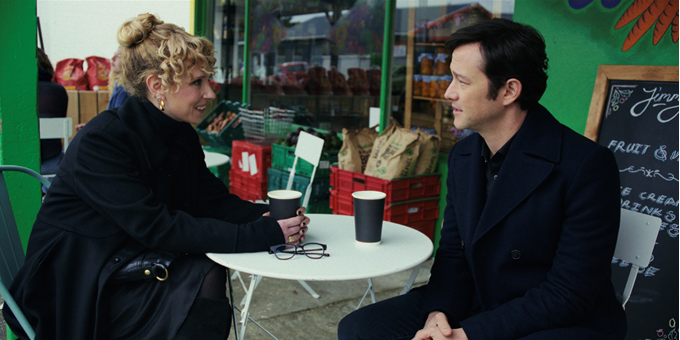
L.A.-based focus-puller Sarah Brandes [ICG Magazine January 2021] agrees. “There was a glorious harmony that made it an absolute delight to go to work every day. After the shutdown, we all kept in pretty close contact with one another. The show inevitably moved to a distant location, and as sad as we were to see it go, we were happy to see it continue. It was nice for those of us who stayed behind to believe it was because of our valiant efforts that it was able to continue.”
Mr. Corman is designed to look like a series of short films, tracing the life of Josh Corman (Gordon-Levitt), a musician who ended up becoming a fifth-grade teacher. Gordon- Levitt says he and Presant worked closely on developing the grammar for the camera work. “I was interested in the kind of intimacy that can come from having fewer cuts,” Gordon- Levitt shares. “So, we said, ‘Let’s figure out what we can do with the camera to intuitively follow the action of the scene and make the audience feel like they’re sitting in the room with us.” Long takes are one of its hallmarks.
To ensure the camera moves reinforced Josh’s mental state, Presant and Gordon-Levitt identified the salient beats of his emotional journey. “While we would design shots that arose from those concepts, we also maintained those designs in a state of plural-potentiality for as long as possible, knowing they could shift and change,” Presant notes. “And leaving them flexible to take new shape and develop alongside the performances. The ability for it to feel imperfect – in the way a person in the space would – worked to remove the artifice of the camera as an objective observer.”
That goal meant having camera operators who connected deeply with the story and characters. Or as Presant describes: “In a way, we were finding another member of the cast because how they would respond and feel to the actors was immensely important.” Myrand was on A-cam and Mark Moore [SOC] shot Steadicam. As noted, Myrand moved with the show to New Zealand, and Bevan Crothers joined as splinter DP.
“With the approach we took – a kind of conscious lens – the camera is following in time with the actor,” Gordon-Levitt adds. “So, Dale was a valuable contributor to the entire process.”
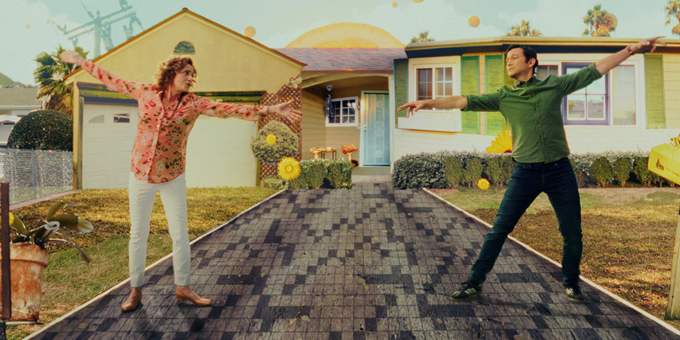
Presant chose ALEXA Mini LF’s for the camera’s functionality and specific attributes of the sensor – latitude quality of the photosites, and quality of the data downstream – and Zeiss Ultra Primes, detuned slightly by Guy McVicker at Panavision to add a slight color aberration. They used a Steadicam in L.A. and a Ronin in New Zealand.
“The look of our show came much more from the image pipeline we built,” Presant expounds, “which took those sensor values and mapped them to the desired response. For Mr. Corman, that was generally contact-printed film, but I adjusted the peak of the highlights to allow for certain characteristics I wanted in the HDR, namely a general highlight roll- off with a nominal punch-through for peak highlights.”
Presant also modified the roll-off to allow for the very darkest blacks to converge on a clean zero point. “The very specific design of the show LUT formed the basis of the look, and then we coupled it with film grain and halation algorithms to give everything a much more organic feel,” he continues. “We are in the very early days of a move toward computational photography, and we have to look at our cameras more as data acquisition device. Just one step in a process rather than the source of our look and feel. The image pipeline as a whole is the true source of our image design.”
To help Myrand be a key part of the action, Brandes focused on the maneuverability of the camera build. “I incorporated his needs for operating, i.e., adjustability of the eyepiece, and lightweight motors on the passenger side of the camera,” she offers. “Every piece was tested for ease of weight and functionality, eliminating anything that would impede the lightest possible build.”
Not every handheld image was shot handheld. Presant created an algorithm to add true handheld motion onto stable images, which Eric Cameron at Fotokem ported into the dailies process in NextLab and the final grade in Resolve. Presant, who Vendler says is one of the most tech-savvy DP’s he’s ever worked with, started with tracking handheld shots and incorporated on-set operation to finesse parallax. This enabled him to manipulate the amount of handheld in post and ramp within shots. “The ability to fine-tune that motion was integral to some of the shots we were designing,” Presant says.
Each day would begin with a rehearsal from a shot design Presant and Gordon-Levitt had developed, and then they would adjust as each beat evolved. Presant used an Artemis Prime digital finder to capture a rough version of each beat so they could look at it together and “discuss it, adjust it, break it, change it, fine- tune it,” he recounts. “It became a process of way-finding where our initial idea blossomed into something new and better, often shifting what the actors were doing and then shifting what I would do with the camera. Doing this quietly, in a space where an exchange of ideas could happen, allowed us to push ideas back and forth between not only Joe and me but the actors and our operators.”
“On the rare occasion that they couldn’t figure out the best way to approach the scene, I would offer a suggestion,” Myrand recalls. “Sometimes they incorporated my idea directly, and sometimes they took it and then it morphed into something even better.”
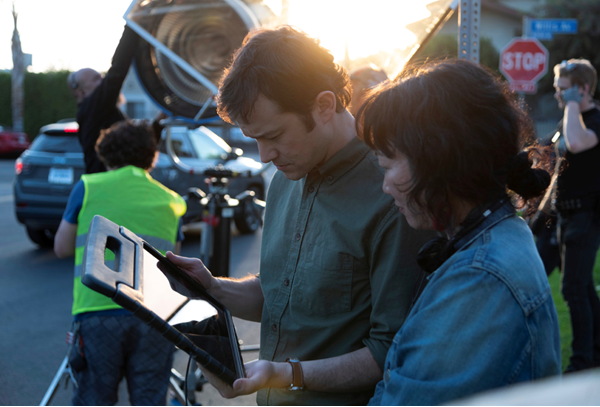
Production Designer Meghan Rogers, who worked on Gordon-Levitt’s feature directorial debut, Don John (2013), was also a key creative partner. As Presant observes: “L.A. has this tendency towards moments of pure beauty amongst all of this mundane city life, and we wanted to build the show around the beauty within the mundane.” Rogers adds: “One of the best parts of designing this show was the opportunity to explore some of the dynamically different places that people live in a sprawling city like Los Angeles. Collaborating with Joe and Jaron to find the visual voice of the city was fun and creatively rewarding.”
For Corman’s day job as a teacher, Rogers says the trio looked for “mundane locations in the San Fernando Valley, with washed-out colors affected by the heat and relentless sun – a color palette of pale lavenders and peaches at dawn through the spectrum of polluted beiges during the heat of the afternoon with the blinding blowout with the sun.”
Nightlife and jaunts into the world of musicians and artists occurred on the Eastside, in Echo Park and the Warehouse District, where the color palette transitioned to jewel tones and saturated colors to create an almost magical after-hours environment, first featured in the opening episode.
“We shot inside and out of this club, using a bit of everything from SkyPanels to Astera Titans to LED Lustr Source 4’s to Chauvet LED to Par cans,” recalls Chief Lighting Technician Manny Tapia. “One cool thing we did was construct retrofitted housings for four S-60 SkyPanels that my rigging team mounted on separate Wacker lights. Those played in the shot and were able to give us on-camera color, and we were able to make them any color we wanted.”
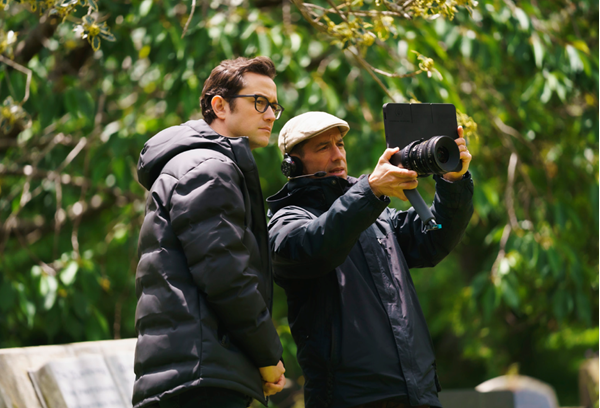
Director of Photography Alex Vendler, who shot VFX Plates and 2nd Unit in L.A., says Gordon-Levitt (L) and Presant (R) “Are at the top of their games, which gives you more excitement. You bring all you’ve got because you feel it’s going to be important.”
For the fantasy sequences, Presant and Gordon-Levitt wanted to avoid slick effects. To create a more low-fidelity feel, they decided the camera wouldn’t pan or tilt, which maximized the pop-up picture-book feel of the composite environment. “Our grip department, led by Sam Strain, and especially our dolly grips Hamish McIntyre and Melissa Ririnui, had their work cut out for them,” Presant describes. “We embraced a 2.5-dimensional world – not true reality in terms of the spaces – and moving the camera in limited ways, accentuated that in the final composite.” Presant and VFX Supervisor Stan Alley collaborated on storyboarding all the sequences and doing previs on the more demanding ones.
Mr. Corman was also an opportunity for Presant to expand his use of an XY lighting system, which allowed for precision matching of the light color of lights on the set. He first used the system on Rampage but was limited at the time to SkyPanels and L-series Fresnels using a look-up from XY to HSI. “We now have a whole array of options,” he shares. “My friend, Steve Yedlin [ASC], developed a process by which we can drive non-XY configured lights in an XY fashion as well as a calculator that allows for calculations on XY coordinates. Because of all this, Mr. Corman was the first show I’ve run completely in XY for every fixture.”
Presant says the montage Josh imagines while stuck in his childhood room in Episode 108 “defined everything exciting to me about the show – the process of lighting with XY, of imaging algorithms, the creative investment of everyone on the team, and all for the telling of a wonderfully emotional moment that lets the actors shine.”
The work was driven off the practicals and the daylight based on real daytime XY values. Shots ranged from simple ones with Gordon-Levitt and Presant alone in a room, to an elaborate 360-degree rotation that required three operators doing hand-offs with a 30- foot bungee rig and the Ronin on the bottom with handheld motion added later. “It was one of those very special days on set,” Present remembers. “I’m smiling just thinking about it. It’s something I’m very proud of, both for my work, but, more importantly, for the integration of everyone’s work.”
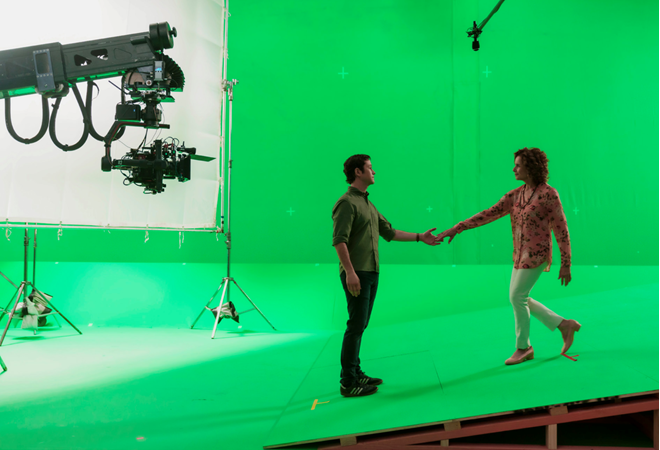
Above/Opposite: A-Camera Operator Dale Myrand, SOC, says “Everyone from both crews, L.A. And Wellington, bought into helping us find the best way to tell joe’s story...most everyone walked away at the end of the day feeling as though they had been directly involved with the product.”
The extensive use of XY was also good news for Colorist Phil Beckner, who calls the system “extremely helpful when trying to match shots within a scene that are intended to take place concurrently but were shot on different days halfway around the world from one another. It also was great for color consistency for setups that we visit often in multiple episodes, like Josh’s apartment.”
One example of that is in Episode 2 when Josh is having a panic attack and thinks he hears something outside. He opens the door and light floods the room. As his eyes adjust, he sees nothing and returns to pacing around the room. The long sequence was captured on a set in New Zealand based on the actual L.A. location. When Vendler was shooting plates of the apartment complex, he also took XY readings of the light used to recreate the ambiance.
As Presant recalls: “Stan called me when they first started doing the composites because he was shocked at how seamlessly they dropped in together. When color is lined up, our brains recognize the continuity and then write off most other discontinuities. As a result, the deep control of color is a very powerful tool in imaging.”
Such results were also on display in a fight sequence in Episode 105 in which the actors morph into fantastical superheroes. It was one of the most challenging scenes of the season, involving two units on two continents working in two passes because of actor availability. The sequence began in New Zealand to make sure eyeline marks were the correct height for specific actors. That metadata was transferred to the L.A. team covering green screen.
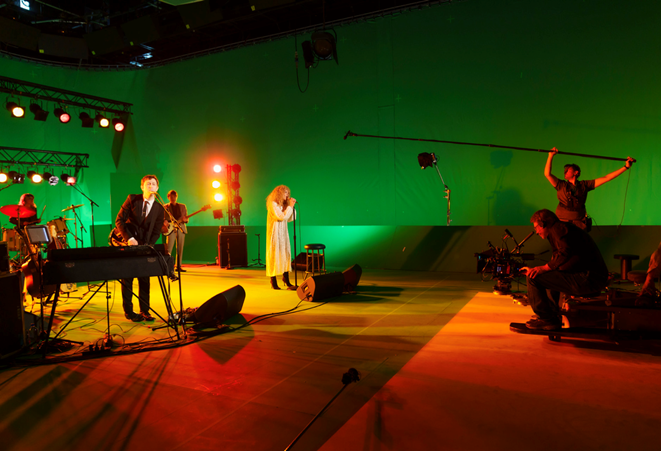
“We had a very high-quality stunt previs to get a complete rendering of the action,” Vendler explains, “which was matched back with real people. Jaron and Joe were watching the takes as we built them.” “All of the lighting was driven by XY with very specific notes on lights, direction and ratios,” Presant adds. “Everything was matched multiple times in New Zealand and notes sent to the L.A. unit. Camera angles were matched with camera moves being solely on one side of the equation – so the move would be in L.A. or New Zealand and the other side would be static with the elements composited into it. Because the lighting was a direct match, everything linked up seamlessly.”
As Vendler adds: “When you’re thoughtful and treat VFX like any other part of your creative process, you maximize the returns and make something as special as every performance and every emotional moment we love about cinema.”
Color workflow on the series started with a timeline provided by Park Road Post. Media was relinked at Fotokem and Beckner would do the first pass of color before collaborating with Presant in real-time in SDR using ClearView Flex. The pipeline was then switched to HDR for another pass, and then uploaded to Moxion for another review by Presant. Beckner addressed notes, then packaged and sent the timeline to Park Road, where Editor Rob Gordon applied finishing touches. Finally, it was sent to Colorist Damian McDonnell for final review and adjustments with Gordon- Levitt.
Apple TV+, which has allowed filmmakers to soar with similar results in shows like Dickinson [ICG Magazine January 2020], Little America [ICG Magazine September 2020], and For All Mankind [ICG Magazine October 2019], helped Mr. Corman embody the promise of creative investment in people and gear to set a new standard for innovation and collaboration. The show that emerges from this blend of human intuition and technological innovation is both otherworldly and familiar – out there in a way that feels good.
“We pursued a process on Mr. Corman much more akin to prototyping in product design,” Presant concludes. “Our way-finding in a collaborative environment created a world where everyone became creatively invested. There wasn’t a feeling of executing a show – more like a group of creative people exploring their limits and finding a show together. It was a massively rewarding process, not only for myself but for everyone on the crew.”
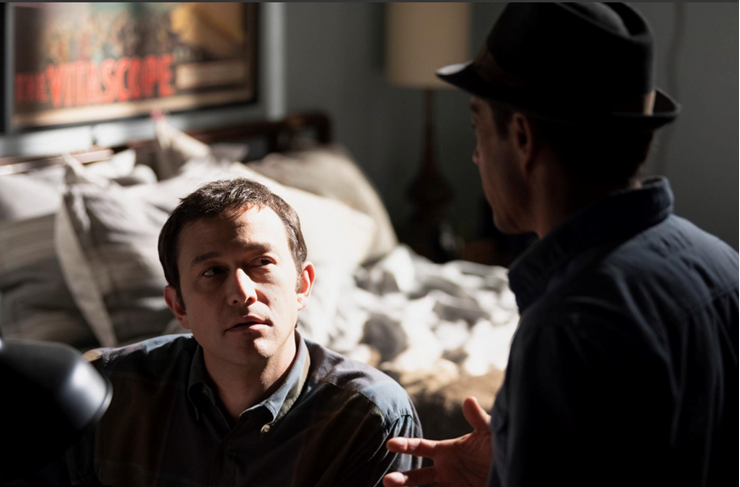
Gordon-Levitt (L) says he and Presant (R) worked closely on developing the grammar for the camera work. “I was interested in the kind of intimacy that can come from having fewer cuts,” Gordon-Levitt shares. “Let’s figure out what we can do with the camera to make the audience feel like they’re sitting in the room with us.”
